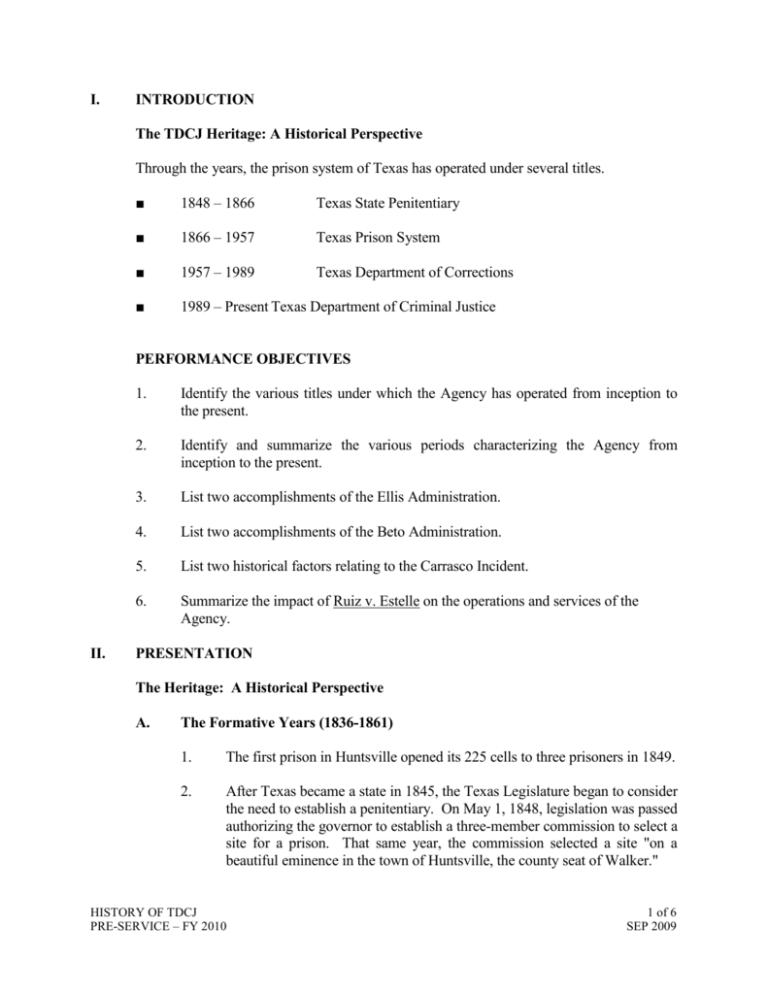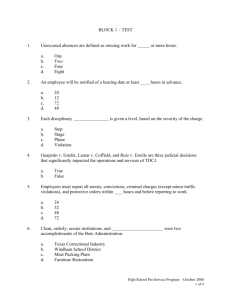TEXAS DEPARTMENT OF CRIMINAL JUSTICE
advertisement

I. INTRODUCTION The TDCJ Heritage: A Historical Perspective Through the years, the prison system of Texas has operated under several titles. ■ 1848 – 1866 Texas State Penitentiary ■ 1866 – 1957 Texas Prison System ■ 1957 – 1989 Texas Department of Corrections ■ 1989 – Present Texas Department of Criminal Justice PERFORMANCE OBJECTIVES II. 1. Identify the various titles under which the Agency has operated from inception to the present. 2. Identify and summarize the various periods characterizing the Agency from inception to the present. 3. List two accomplishments of the Ellis Administration. 4. List two accomplishments of the Beto Administration. 5. List two historical factors relating to the Carrasco Incident. 6. Summarize the impact of Ruiz v. Estelle on the operations and services of the Agency. PRESENTATION The Heritage: A Historical Perspective A. The Formative Years (1836-1861) 1. The first prison in Huntsville opened its 225 cells to three prisoners in 1849. 2. After Texas became a state in 1845, the Texas Legislature began to consider the need to establish a penitentiary. On May 1, 1848, legislation was passed authorizing the governor to establish a three-member commission to select a site for a prison. That same year, the commission selected a site "on a beautiful eminence in the town of Huntsville, the county seat of Walker." HISTORY OF TDCJ PRE-SERVICE – FY 2010 1 of 6 SEP 2009 B. The Civil War (1861 - 1865) 1. 2. C. D. Products from the prison cotton mill were sold to the public. Eventually the mill, manned by convicts from Texas, Louisiana and Arkansas, as well as laborers from the free-world, assisted the Confederacy during the Civil War. As the manpower pool dwindled due to the war, Union prisoners of war were used in the manufacturing effort. In December 1865, the Thirteenth Amendment to the United States Constitution abolished slavery throughout the nation. However, prisoners remained slaves of the State. Texas prisoners were used to help fill the labor void left by the abolition of slavery. The Labor / Lease Period (1866 - 1909) 1. In 1866 the Texas Legislature established the Board of Public Labor and directed its members to serve contracts with private interests for the use of inmate labor. 2. "A convicted felon, whom the law in its humanity punishes by confinement in the penitentiary instead of death, is subject while undergoing that punishment, to all laws which the legislature in its wisdom may enact…He has, as a consequence of his crime, not only forfeited his liberty, but all his personal rights except those which the law in its humanity accords him. He is for the time being a slave of the State. He is a civiliter mortuus; and his estate, if he has any, is administered like that of a dead man." Ruffin v. Commonwealth (1871) The Farm System (1910 - 1936) Large agricultural ranching operations became hallmarks of the prison system. E. The Decline (1937 - 1947) 1. The period from 1937 - 1947 was characterized as a time of decline and backsliding for the Texas Prison System. The offender population kept increasing, but the productivity of the farms remained about the same. The system was permeated with brutality, self-mutilation, sexual perversions, incompetence and petty theft. 2. "At the Darrington Farm, where most of the prisoners under 25 who have been to the penitentiary once or more are kept, the 333 inmates live in tanks that were designed for 250 inmates. They are sleeping in double-deck bunks so close together it is hard to see how they can get enough fresh air. The stench is awful for they get soap enough for only one-fourth of the men in the tanks to get a soap and water bath every three weeks; and at this farm there is no provision for the prisoners to wash their clothing. In rainy HISTORY OF TDCJ PRE-SERVICE – FY 2010 2 of 6 SEP 2009 weather the prisoners are unable to wash their own clothing, even in plain water. At the Retrieve Farm inmates are so crowded they actually sleep on the floor. I.K. Kelly, Warden of the farm, said the unit was designed to take care of 350 men and the population is currently 475. More than 100 men are assigned to sleep on the double-decker bunks jammed against one another. In one tank, 31 prisoners are sleeping on the brick floor."The Houston Chronicle (1 F. The Reform Years (1947-1973) 1. The Ellis Administration (1948 -1961) O.B. Ellis was appointed as a reform-minded Director of the Texas Prison System. He initiated broad-scale improvements in agricultural operations; vocational training and educational programs; and housing and salaries for staff. The prison system became much more self-sufficient under his direction. ESSENTIAL ELEMENTS 1. ____________________, ___________________, and __________________ were three accomplishments of the Ellis Administration. 2. The Beto Administration (1962 - 1972) Dr. George Beto was selected as Director of the Texas Department of Corrections upon the death of O.B. Ellis. He continued many of the Ellis reforms. Another accomplishment of the Beto Administration was the Windham School District. The Texas Department of Corrections became nationally known for its clean, orderly and secure institutions under his leadership. In 1964, the U.S. Supreme Court held in Cooper v. Pate (378 U.S. 546/1964) that prisoners have the right to challenge administrative practices in prison. In 1971, Guajardo v. Estelle established that TDC could not deny inmates the right to correspond with inmates on the same or different units pertaining to legal matters. In 1972, Lamar v. Coffield prohibited TDC from racially segregating offender housing and job assignments. “Though we may be dealing here with some of the most incorrigible members of our society (although not solely), how we treat these particular HISTORY OF TDCJ PRE-SERVICE – FY 2010 3 of 6 SEP 2009 individuals determines to a large extent, the moral fiber of our society as a whole; and if we trespass beyond the bounds of decency such excesses become an affront to the sensibility of each of us.” Circuit Judge Tuttle - Novak v. Beto ESSENTIAL ELEMENTS 1. __________________________ and ____________________________ accomplishments of the Beto Administration. G. were two Conflict and Consolidation (1973-1998) 1. The Estelle Administration (1972 - 1983) In 1974, Judge William Wayne Justice, United States District Court (Eastern District of Texas) consolidated eight separate offender petitions into a class action suit entitled Ruiz v. Estelle. Judge Justice requested that the U.S. Department of Justice investigate the facts alleged in the prisoners' complaints and participate with the full rights of a party to the suit. 2. The Carrasco Incident 3. The Pack/Moore Homicides – an offender was acquitted for the homicides of a Warden and top prison official. This caused much outrage amongst prison staff and concerns for staff safety. 4. The Death of Minnie Houston – One of the first female correctional officers was murdered by an offender in the Officers Dining Hall. This raised additional concerns for the suitability of female correctional officers in male facilities (female correctional officers were allowed in male facilities as a result of K.K. Coble vs. TDCJ). 5. The Texas Department of Criminal Justice (TDCJ) is established in 1989. ESSENTIAL ELEMENTS 1. 2. ______________________ and _____________________ are two historical factors relating to the Carrasco Incident. _______________________________, __________________________, and _______________________________ are three judicial decisions that significantly impacted the operations and services of the TDCJ. HISTORY OF TDCJ PRE-SERVICE – FY 2010 4 of 6 SEP 2009 H. Recent History (1998-Present) 1. End of Ruiz/Federal Oversight - On June 17, 2002, the civil action of Ruiz v. Estelle was dismissed, thereby ending the federal oversight of the Texas Department of Criminal Justice. 2. Connally Seven a. b. c. Amended Count Procedures Revised Security Procedures (Additional Guidance and Clarification) Modified the Offender Classification Plan to Include Reassignment of Offenders to More Appropriate Security Levels 3. The Homicides of Daniel Nagle/Stanley Wiley/Rhonda Osborne – These homicides brought about an unprecedented review of officer safety. Initiatives included the installation of body alarms, the use of carry-onperson chemical agents, Defensive Tactics Training (to include the 60 Second Survivor), the use of thrust vests (stab-resistant vests), and BOSS chairs (chairs that x-ray the orifices of offenders to reveal hidden contraband). 4. Hurricane Rita Response Prior to the huge Category 3 hurricane making landfall near Sabine Pass in far Southeast Texas, TDCJ completed its largest evacuation ever, utilizing ground vehicles and aircraft to move more than 9,400 offenders to safety. 5. CID Reorganization The Correctional Institutions Division was reorganized to enhance communication, coordination, consistency/uniformity, and access to resources. It is initially expected to be staffing and cost neutral with possible future fiscal benefits as we explore opportunities to more efficiently share resources. The CID facilities were reorganized into six geographical regions instead of the current five geographical regions and one mission (state jail) oriented region. 6. ACA Accreditation HISTORY OF TDCJ PRE-SERVICE – FY 2010 5 of 6 SEP 2009 III. IV. APPLICATION SUMMARY Through times of trials and tribulations, years of decline and progressive leadership, periods of order and controversy, the prison system of Texas continues to evolve through its heritage and the legacy passed down by those who have come before us into what is now a dynamic and exemplary correctional entity - the Texas Department of Criminal Justice. V. EVALUATION Written Examination HISTORY OF TDCJ PRE-SERVICE – FY 2010 6 of 6 SEP 2009







